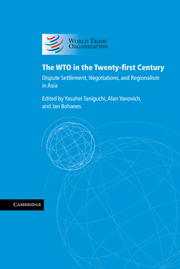Book contents
- Frontmatter
- Contents
- Notes on contributors
- Acknowledgements
- Table of dispute settlement cases and reports
- List of abbreviations
- Introduction
- PART I The WTO at Ten
- PART II Accomplishments and Future Prospects of the WTO Dispute Settlement System
- PART III Asian Perspectives on WTO Dispute Settlement
- PART IV The Doha Development Agenda and Beyond
- PART V Asian Regional Integration and the Multilateral Trading System
- 22 The adoption of the ‘Best Practices’ for regional and free trade agreements in APEC: a road towards more WTO-consistent regional trade agreements?
- 23 Trade remedy systems for East Asian free trade agreements
- 24 Free trade agreements in Asia and some common legal problems
- 25 Dispute settlement under free trade agreements: its interaction and relationship with WTO dispute settlement procedures
- 26 Regionalism under the WTO and the prospect of an East Asian free trade area
- Index
26 - Regionalism under the WTO and the prospect of an East Asian free trade area
from PART V - Asian Regional Integration and the Multilateral Trading System
Published online by Cambridge University Press: 05 March 2012
- Frontmatter
- Contents
- Notes on contributors
- Acknowledgements
- Table of dispute settlement cases and reports
- List of abbreviations
- Introduction
- PART I The WTO at Ten
- PART II Accomplishments and Future Prospects of the WTO Dispute Settlement System
- PART III Asian Perspectives on WTO Dispute Settlement
- PART IV The Doha Development Agenda and Beyond
- PART V Asian Regional Integration and the Multilateral Trading System
- 22 The adoption of the ‘Best Practices’ for regional and free trade agreements in APEC: a road towards more WTO-consistent regional trade agreements?
- 23 Trade remedy systems for East Asian free trade agreements
- 24 Free trade agreements in Asia and some common legal problems
- 25 Dispute settlement under free trade agreements: its interaction and relationship with WTO dispute settlement procedures
- 26 Regionalism under the WTO and the prospect of an East Asian free trade area
- Index
Summary
Regional trade agreements (RTAs) were permitted under Article XXIV of the General Agreement on Tariffs and Trade (GATT) 1947 and the Decision on Differential and More Favourable Treatment, Reciprocity and Fuller Participation of Developing Countries (Enabling Clause). RTAs are classified into customs unions, free trade areas and interim agreements leading to the formation of either, based on the criteria of ‘substantially all the trade’ and ‘not on the whole higher or more restrictive’. RTAs formed by developing countries are afforded more favourable treatment. Article XXIV of the GATT 1947 and the Enabling Clause were incorporated into the World Trade Organization (WTO) agreements, together with a new Understanding on the Interpretation of Article XXIV of the General Agreement on Tariffs and Trade 1994. The General Agreement on Trade in Services (GATS) adds another dimension to these exceptions from the most-favoured nation (MFN) principle, namely RTAs involving trade in services, with similar conditions applying as to RTAs on trade in goods.
Customs unions and free trade areas evolved from the frontier traffic between adjacent countries, which were ‘grandfathered’ by the GATT 1947 as a fact of life. Currently such agreements have to be notified to the Council for Trade in Goods (RTAs under Article XXIV), Committee on Trade and Development (RTAs under the Enabling Clause) or Council for Trade in Services (RTAs covering trade in services), and examined by a Working Party formed by the WTO Committee on Regional Trade Agreements (CRTA), which was established by the WTO General Council in February 1996.
- Type
- Chapter
- Information
- The WTO in the Twenty-first CenturyDispute Settlement, Negotiations, and Regionalism in Asia, pp. 472 - 482Publisher: Cambridge University PressPrint publication year: 2007

